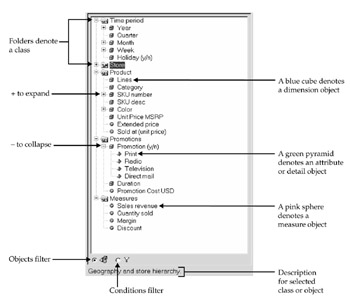Chapter 8: Classes and Objects
|
| < Day Day Up > |
|
Classes and objects are the primary items a user sees when building a new query or working with an existing report. Classes allow you to organize objects into topics, similar to the way you organize documents into file folders. Objects correspond to columns of data in a database table. However, objects can be much more powerful than raw data lists, enabling you to add intelligence such as aggregations, transformations, variables, and formatting. Chapter 8 focuses on the basics of classes and objects, whereas Chapters 9 and 10 provide information to make your objects more robust.
The Universe Pane
The Universe pane provides information on the classes and objects. Unless an individual class or object is marked as hidden, Figure 8-1 is what users will see when they create a new query or insert a table or graph into an existing document.

Figure 8-1: The Universe pane shows classes and objects that appear to users when they build a query.
Click the + sign to expand items in a class or the - sign to collapse the individual objects within a class.
You can have multiple levels of classes for classes that have a large number of objects such as Store Details within Store. These groupings are purely to ease navigation for the users. If you have a lot of detail information that is not used on a regular basis, placing these objects further within a subclass makes the universe appear less busy or difficult. However, if the information is used frequently, do not bury the objects.
In the EFASHION universe, the promotional media of Print, Radio, Television, or Direct Mail are details of the base object Promotion (y/n). These details become organized in a separate folder within Promotion (y/n), making the universe appear less cluttered. Specifying an object as a detail rather than a dimension also means it will not be available for multidimensional analyses. Some MOLAP tools differentiate between base dimensions and details (usually called attributes), which can greatly affect cube size and query performance. This is not true with BusinessObjects: denoting an object as a detail is more for organizational purposes and does not affect performance.
| Note | In this example, a better business design would have been to have an object called Media in which the four different types are the data elements (print, radio, television, direct mail). This kind of design would reduce the number of objects as well as facilitate crosstab reporting and multidimensional analyses. |
Within the Universe pane, you can specify if you want to display regular classes and objects or condition objects, a special object used to generate a SQL WHERE clause.
|
| < Day Day Up > |
|
EAN: 2147483647
Pages: 206